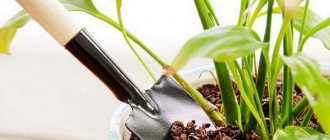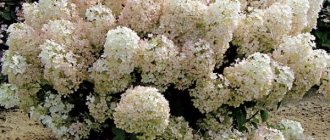Plants » Flowers
0
625
Article rating
Kira Stoletova
Hydrangea has a very surprising property - it is able to change color or its intensity depending on the acidity of the soil. What additives should be added for this purpose? What needs to be done to achieve maximum effect without harming the culture in this case?
How to acidify soil for hydrangea
What soil does hydrangea need?
The most favorable soil for hydrangeas is clayey, slightly acidic soil. It is this composition that guarantees lush flowering and rich color of the petals. Plants do worst in sandy or alkaline soil. Neutral soil allows you to grow hydrangeas whose inflorescences are light in color.
Hydrangeas - flowering shrubs
Depending on the acidity level, the color of the petals can vary from dark purple to pale pink. Experienced gardeners know how to achieve certain shades using various additives when watering. For example, manganese is used to produce pink flowers. An alternative solution is citric acid for hydrangea; the proportions are determined by the required color. Lemon and vinegar are used to create darker shades of blue. The dependence of flower color on acidity indicators is clearly shown in the table.
| pH | Coloring of inflorescences |
| 4 | Violet |
| 4,5 | Blue |
| 5,5 | Blue |
| 6,5 | Dark pink |
| 7 | Light pink |
It is important to know! To maintain the required color, maintain an appropriate level of soil acidity.
FAQ
To clarify the most important points, we will answer the most frequently asked questions.
What happens if you over-acidify the soil?
Vegetable crops will not grow on acidified soil, but hydrangea feels good. If the acidity index is below 4, then think about the opposite action - increasing the amount of alkali.
How to fix the situation after watering
The following will help increase the amount of alkali and reduce the acidity in the soil:
- dolomite flour;
- slaked lime;
- chalk;
- wood ash.
Information on neutralizing soil after severe acidification:
How to acidify soil for hydrangea
Soil for hydrangea - how to acidify soil for hydrangea
To acidify the soil, additives are used that are dissolved in water for irrigation. Depending on how much it is necessary to increase the pH level, substances with varying degrees of acidification are used. It is worth taking a closer look at how to acidify the soil for hydrangea.
Flower color depends on pH level
About the flower
Hydrangea is a plant that belongs to the Hydrangeaceae family. There are about 70 varieties of the flower, but 10 types are most commonly used. In the Russian Federation, tree and paniculate hydrangeas are grown, and large-leaved plants are also very often planted. Colors, sizes, shapes, etc. depend on the type of flower.
Attention: When planting hydrangea, you need to choose the right location for it, since children should not get close to the bush, because it produces cyanide, which is dangerous to health.
It happens that the leaves of the plant begin to acquire a yellow tint. This is a direct sign of lack of humidity. Hydrangea needs to be constantly watered to avoid this phenomenon. Most often, the plant is grown at home, but nowadays there are many varieties that are not afraid of frost, but require preventive shelter for the winter.
The flower is loved by landscape designers; hedges and gardens are often decorated with hydrangea. The plant can be planted with a variety of neighbors, which must be chosen very carefully.
Attention: Hydrangea should be planted next to plants that do not have a superficial root system.
Using popular tools
How to Change Hydrangea Color and Make Hydrangea Blue
Each method deserves special attention:
- Lemon acid. To obtain a solution, you need to mix 12 liters of water with 1 tsp. citric acid. Watering is carried out every 25-30 days to maintain the optimal acidity level. An alternative is to use lemon juice.
- Table vinegar. Use 9% essence, which is diluted in water in a ratio of 200 g per 20 liters. The method allows you to acidify the soil, but the effect is short-lived. It has been noticed that the use of vinegar negatively affects the soil microflora.
- Succinic acid. The use of this drug not only increases the acidity of the soil, but also serves as a fertilizer for the plant. The solution is prepared at the rate of: 3 tablets per 1 liter of water. If the drug is purchased in a different form, then you should adhere to the proportions on the package in order to feed the flower and not harm it.
- Apple vinegar. The solution is prepared from a bucket of water and 1 tablespoon of vinegar. Acidify the soil no more than once every 3-4 months. It significantly increases acidity and is less harmful than table vinegar. This acidifier still has a negative effect on the soil.
- Oxalic acid. Once every 1-2 months, watering is carried out with water containing oxalic acid, which is added in a ratio of 100 g per 10 liters. It is advisable to first dilute the required amount of crystals in a glass of warm liquid, and then add this solution to a bucket of water.
Popular means for soil acidification
Most gardeners prefer to use succinic and oxalic acid. Citric acid is often used for hydrangea. Vinegar is used less frequently due to its negative effect on the state of soil microflora. How to water hydrangea with vinegar and whether it can be done - each gardener decides for himself.
Note! It is important to strictly observe the proportions for preparing solutions. Failure to comply with them can lead to deterioration in the condition of the plants.
Advantages and disadvantages
Advantages of the product:
It is difficult to identify the disadvantages of the product - no contraindications or negative reactions have been recorded.
However, there are features of the action and use of the drug:
it is important to study the instructions and follow the recommendations when diluting mixtures; take into account expiration dates and storage conditions (information is written on the packaging); It is not advisable to dilute the solutions before processing; it is not advisable to leave the finished mixture in reserve - the beneficial properties are retained for 3-4 hours;
Application of mineral oxidizing agents
Why do hydrangeas have small inflorescences - reasons and solutions to the problem
Preparations such as colloidal sulfur and sulfates are used to oxidize heavy clay soil. They have a strong and long-lasting effect. Features of application:
- Colloidal sulfur. The drug is applied in dry form under each bush at the rate of 30 g per 1 m². The surface of the soil is loosened and the powder is buried 15 cm. The method is used in the fall so that its activation begins in the spring under the influence of melt water. It is enough to add sulfur once every 2 years.
- Sulfates. Iron sulfate is used in the amount of 50 g per 1 m² of area. Apply dry in the fall directly to the soil. Sometimes ammonium sulfate is used (at your own risk).
- Ammonium nitrate and potassium sulfate. The drugs are relevant only when the deviation from the norm is insignificant. A solution of nitrate is prepared at the rate of 30 g of the drug per 10 liters of water. Apply under each bush in spring or autumn.
Helpful information! It is better to use mineral oxidizing agents as rarely as possible. Frequent application of such drugs can harm plants.
Organic acidifiers
There are several methods for making the soil acidic for hydrangeas. They involve adding natural components to the soil or mulching the surface around the plants.
Natural products are environmentally friendly and safe
Current tips:
- Leaf humus. It is preferable to use rotted oak leaves. Adding compost to the soil increases acidity and also enhances its nutritional value.
- Larch needles. Coniferous tree needles are used to mulch plantings.
- High peat. It is used as mulch or added to the soil for planting hydrangeas. Acidity increases significantly, but the process will take some time.
Methods that involve the use of organic matter to acidify the soil are environmentally friendly and beneficial. The only drawback is the delay in action. For this reason, humus or peat is added to the site in advance.
Additional Information! High-moor peat should only be used to acidify the soil. Only lowland peat is suitable as mulch or fertilizer for flowers.
Precautionary measures
To avoid causing harm to flowers, it is important to follow a number of rules during the propagation process:
Acidification of soil for hydrangea
- choose a suitable location;
- provide nutritious soil;
- Water regularly and in a timely manner, trying to do it closer to the roots, without touching the foliage and stems, making sure that the moisture in the soil does not stagnate;
- maintain the permeability of the soil by adding peat and sand to it for better penetration of moisture to the root system;
- loosen the soil after each moistening;
- apply the required fertilizers on time and to the recommended extent;
- carry out pruning.
Recommendation: to avoid lack of moisture, it is advisable not to plant hydrangea in close proximity to vegetation that has a shallow root system.
Soil oxidation technology
It is important to follow a strict sequence of actions aimed at increasing soil acidity. Initially, the pH level is determined by using litmus paper. It can be purchased at any garden center and measurements are taken according to the instructions included with the product. There are several rules:
- to slightly increase acidity, use a solution of citric acid or ammonium nitrate;
- Vinegar and citric acid will help quickly improve performance;
- You can safely acidify the soil by adding high-moor peat or oak leaf compost to the soil.
Some substances are dissolved in water, and some preparations are embedded in the soil in the fall in dry form. It is necessary to strictly observe the proportions; watering the tree hydrangea with citric acid and other solutions is carried out only at the root. The key to success is adherence to technology. Otherwise, home flowers will be damaged.
Failure to comply with proportions leads to plant diseases
How to maintain the resulting acid-base balance
As paniculata hydrangea grows, the acidity of the soil in the area changes. Indicators may deviate from the norm. To maintain pH at a given level, watering with solutions of citric, succinic and oxalic acid is used. The preparations are able to maintain the acid-base balance, favorable for hydrangeas.
Mulching with peat and pine needles throughout the entire period of growth and flowering helps to increase acidity. The mulch layer is updated annually, replacing the substrate completely or thickening its layer. This rule also applies to oak leaf compost, which is used to mulch plantings.
The mulch layer needs to be updated
Means for increasing the amount of alkali
Sometimes there is a need to return the acidity level to its original values. This is usually due to the fact that other plants that prefer a more alkaline environment are supposed to be planted in the place where hydrangeas grow. In this case, there is a need for soil deoxidation. Lime is most often used for this purpose.
Liming the soil involves a number of actions:
- Ground limestone is poured into a barrel, pot or other container and filled with water. 1 part limestone requires 10 liters of water.
- The soil is watered with lime infusion. After 2-3 days, they begin sowing or planting plants.
Chalk can be used instead of lime. The main condition is that it is applied in the spring before harrowing. Use crushed dry chalk, which is used at the rate of 100-200 g per 1 m². The amount of the substance depends on the degree of acidity of the soil and the indicators to which it must be reduced.
Dolomite flour can be used as an alternative to lime, but this is not safe. For some crops, such deoxidation is harmful.
Note! Dolomite flour should not be added to the area intended for gooseberries, sorrel, blueberries and cranberries.
Hydrangeas have special soil requirements. Alkaline soil is not suitable for them - they prefer acidic and slightly acidic soils. In most cases, it is necessary to artificially increase the acidity level and maintain it throughout the life of the plants. You can use different methods, but each gardener decides for himself how to acidify hydrangea.
Features of agricultural technology
Fertile clay areas with low acidity are most suitable for growing hydrangea. Hydrangea grows very poorly in sandy areas, but a little better in red soils.
Prolonged sunlight and lack of wind are very important for the plant. It is advisable that the sun be on the site in the first half of the day. When growing a plant in partial shade, it is not possible to achieve abundant flowering.
Hydrangea
When growing hydrangea using slightly acidic compounds, you can get the brightest flowers possible. If the balance is neutral, then the plant's growth decreases and the flowers lose their brightness. Alkaline soils are not at all suitable for the flower. The plant grows very well on soil collected from the area where coniferous trees grow.
Note! In some types of hydrangea, the color of the flowers directly depends on the balance of the soil. With increased acidity, you can see blue flowers, when grown on neutral soils - white or beige, on alkaline soils - pink or lilac.











